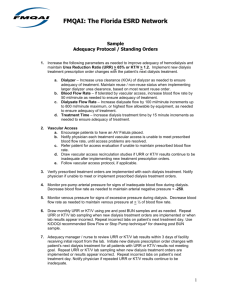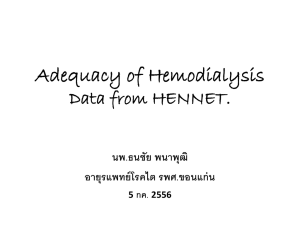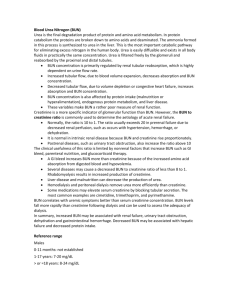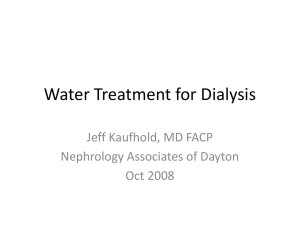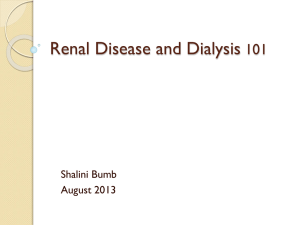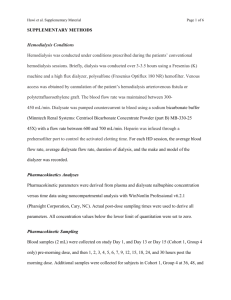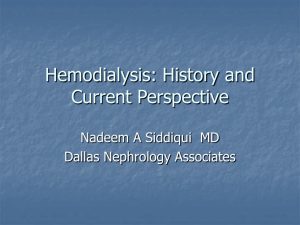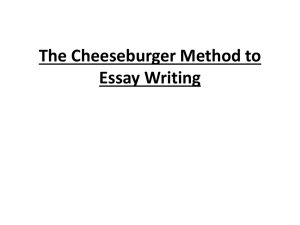Hemodialysis Adequacy - ANNA Jersey North Chapter 126
advertisement
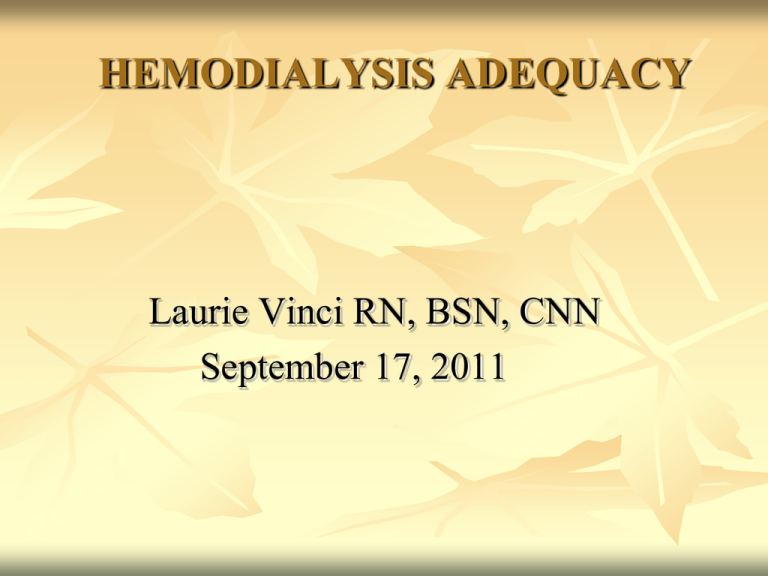
HEMODIALYSIS ADEQUACY Laurie Vinci RN, BSN, CNN September 17, 2011 OBJECTIVES Identify adequacy of dialysis and it’s components Discuss K-DOQI Guidelines for hemodialysis adequacy Discuss nursing interventions to achieve adequate dialysis Definition: Hemodialysis Adequacy The delivered dose of hemodialysis that will optimize the survival and well-being of the patient Numerous studies have demonstrated a correlation between the delivered dose of hemodialysis and patient mortality and morbidity Components of Hemodialysis Adequacy Delivered dose of hemodialysis (HD) should be measured at regular intervals no less than monthly Two components of HD adequacy: 1) Urea Kinetic Modeling (Kt/V) 2) Urea Reduction Ratio (URR) NKF-KDOQI, 2006, CPG 2 Kt/V (Dose of Dialysis) K = Urea clearance through dialysis t = Time of dialysis in minutes V = Volume of urea in proportion to volume of body water Urea Reduction Ratio (URR) Difference between pre and post BUN Statistically significant predictor of mortality URR = PRE BUN- POST BUN X 100 PRE BUN Methods for Dialysis BUN Blood Sampling Pre/Post dialysis blood samples must be from same session Avoid dilution of pre BUN sample (with heparin/saline) NKF-KDOQI, 2006, CPG 3 SLOW FLOW/STOP PUMP METHOD AT COMPLETION OF DIALYSIS: 1) Turn dialysate flow off, decrease UFR to 50 ml/min, lowest TMP or off 2) Decrease BFR to 100 ml/min for 15 seconds A) Slow Flow: After 15 seconds, leaving blood pump at 100 ml/min, draw BUN sample from port on arterial line. Stop blood pump and terminate treatment per unit protocol. OR B) Stop Pump: After 15 seconds, stop pump, clamp arterial and venous blood lines, draw BUN sample from arterial needle tubing, then terminate treatment per unit protocol Minimally adequate HD HD treatment 3 x week Kt/V 1.2 or URR 65% Target dose of HD Kt/V 1.3 or URR 70% NKF-KDOQI, 2006, CPG 4 Dose of dialysis should not be based solely on the URR and/or Kt/V. Other factors need to be included: 1) Potassium removal 2) Correction of acidosis 3) Sufficient protein/caloric intake to prevent malnutrition 4) Longer time for fluid removal Control of Volume and Blood Pressure Blood pressure control improves patient outcomes UF should be optimized with a goal to render the patient euvolemic and normotensive Restrict Na intake to 2 gms/24 hrs Increasing positive Na+ balance by “Na profiling” or using a high dialysate Na+ concentration should be avoided NKF-KDOQI, 2006, CPG 5 Strategies to Minimize Hypotensive Symptoms Avoid excessive UF Slow the UF rate Perform isolated UF (SUF) Manipulate Na levels (modeling) Decrease dialysate temperature from 37C to 34-35C (need MD order) Administer midodrine pre dialysis (MD order) Manage Hemoglobin Optimize patient behavior through education Interventions: Evaluate elements of HD treatments that may compromise urea clearance Assess for access recirculation Verify flow of blood through the access (especially if loop graft) Inadequate blood flow from the access resulting in decreased blood flows Dialyzer blood leak on day Kt/V and/or BUN drawn Inefficient dialyzer DFR set too low Inadequate coagulation Inadequate dialyzer reprocessing Review Treatment Documentation on day of Kt/V and URR Review prescribed treatment vs. actual treatment parameters Review Blood Flow Rate and Dialysate Flow Rate Assess for Lab and Blood Sampling Errors Lab errors Dilution of pre BUN with N/S or heparin Drawing pre BUN after HD initiated Drawing post BUN before HD completed or drawing sample late (>3 mins. after completion) Blood lines or needles reversed Assess Reductions in Treatment Times Treatment 5 Minutes Week 15 Minutes Month 65 Minutes (1.08 Hours) Year 780 Minutes (13 Hours/0.54 Days) 10 Minutes 30 Minutes 130 Minutes (2.17 Hours) 1,560 Minutes (26 Hours/1.08 Days) 15 Minutes 45 Minutes 195 Minutes (3.25 Hours) 2,340 Minutes (39 Hours/1.63 Days) 20 Minutes 60 Minutes (1 Hour) 260 Minutes (4.33 Hours) 3,120 Minutes (52 Hours/2.17 Days) 25 Minutes 75 Minutes (1.25 Hours) 325 Minutes (5.42 Hours) 3,900 Minutes (65 Hours/2.71 Days) 30 Minutes 90 Minutes (1.5 Hours) 390 Minutes (6.5 Hours) 4,680 Minutes (78 Hours/3.25 Days)

